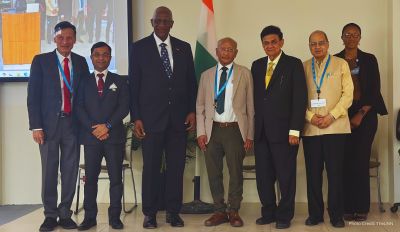The U.S. space agency NASA has exchanged data of its current Mars mission with its counterparts in China, India, the UAE and the European Space Agency to lower the risk of a collision as their spacecraft were also currently hovering the red planet, a media report said on March 31.
The purpose of exchanges was to lower the risk of a collision, as their spacecraft are orbiting the red planet, Hong Kong-based South China Morning Post reported, quoting a NASA (National Aeronautics and Space Administration) statement as saying.
“To assure the safety of our respective missions, NASA is coordinating with the UAE, European Space Agency, Indian Space Research Organisation and the China National Space Administration, all of which have spacecraft in orbit around Mars, to exchange information on our respective Mars missions to ensure the safety of our respective spacecraft,” NASA’s statement said.
“This limited exchange of information is consistent with customary good practices used to ensure effective communication among satellite operators and spacecraft safety in orbit,” the report said.
ISRO’s Mars Orbiter Mission, Mangalyaan, spacecraft remained in Mars orbit since it entered there in 2014.. India is the first Asian country to successfully send a spacecraft to Mars. NASA’s Perseverance has landed on Mars last month and its rover is currently exploring its surface, while China’s Tianwen-1 consisting of an orbiter, a lander and a rover, entered the parking lot of orbit around Mars on February 24 and expected to land there in the next few months.
United Arab Emirates (UAE) spacecraft, Hope, is also orbiting the Mars planet. There are two spacecraft from the European Space Agency in the Martian orbit, the report said. For information exchange cooperation with China, NASA had sought approval from the U.S. Congress and spoke to CNSA, the U.S. space agency confirmed on Monday, the Post report said.
Previously the U.S., Russia, EU besides India have succeeded in sending spacecraft to Mars regarded as the most complex space mission. Indian education success a model for replication, finds UK’s race report
Indian pupils tend to perform well in education and also go on to have high average incomes as a result, a model that needs further research to be replicated across other ethnicities, finds a new review set up by Prime Minister Boris Johnson into the UK’s racial disparities.
The Commission on Race and Ethnic Disparities report released on Wednesday concluded that class differences had overtaken racial disparity as an impact on life chances in the UK and overall found the country to be fairer even though overt racism remained a reality, particularly online.(Shutterstock)
Indian pupils tend to perform well in education and also go on to have high average incomes as a result, a model that needs further research to be replicated across other ethnicities, finds a new review set up by Prime Minister Boris Johnson into the UK’s racial disparities.
The Commission on Race and Ethnic Disparities report released on Wednesday concluded that class differences had overtaken racial disparity as an impact on life chances in the UK and overall found the country to be fairer even though overt racism remained a reality, particularly online.
One of its central recommendations includes discontinuation of the term BAME, which stands for Black, Asian and Minority Ethnic, as no longer “helpful” and proposes references such as British Indian instead.
“It is the commission’s belief that educational success should be celebrated, replicated and used as an exemplar to inspire all pupils across the UK. Evidence shows that certain ethnic groups such as Black African, Indian and Bangladeshi pupils perform better than White British group, once socio-economic status is taken into consideration,” reads the report, chaired by education consultant Dr Tony Sewell.
“This outstanding performance is in part due to what is termed ‘immigrant optimism’: a phenomenon where recent immigrants devote themselves more to education than the native population because they lack financial capital and see education as a way out of poverty. In practice, this means there are significant factors at play that can help groups overcome their socio-economic status and succeed,” it reads.
The 258-page report recommends the Department for Education (DfE) must invest in “meaningful and substantial research” to understand and replicate the underlying factors that drive the success of the high performance of pupils from different ethnicities, such as British Indians.
“In fact, as of 2019, the ethnicity pay gap – taking the median hourly earnings of all ethnic minority groups and the White group – is down to just 2.3 per cent and the White Irish, Chinese and Indian ethnic groups are on average earning notably more than the White British average,” it adds.











